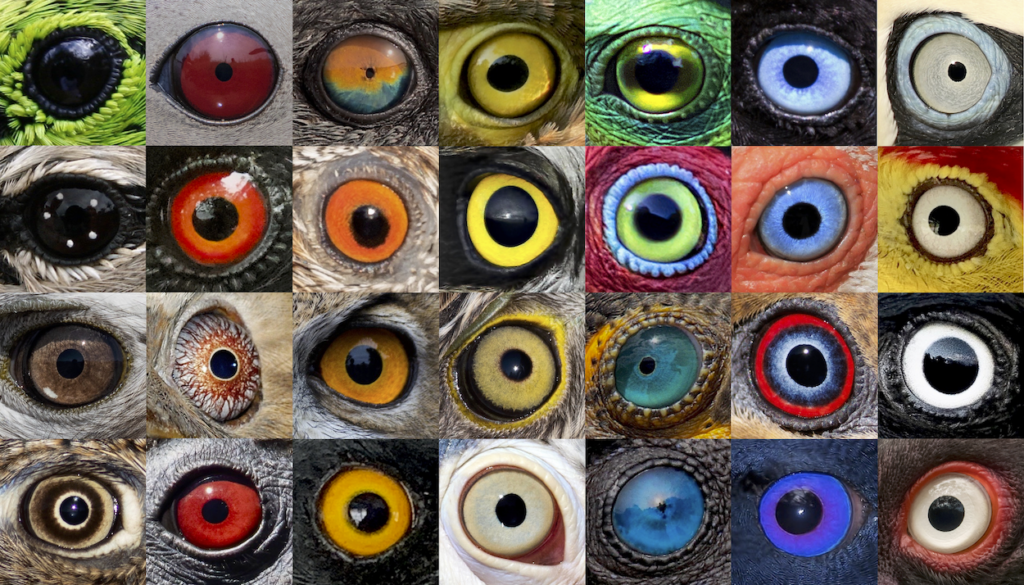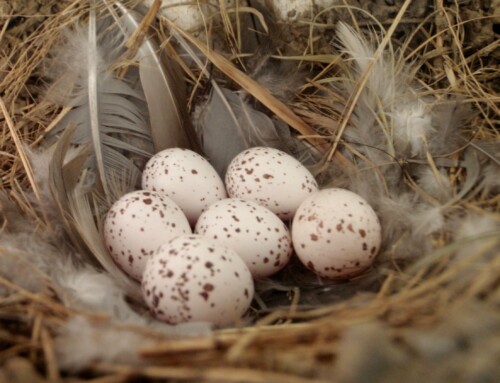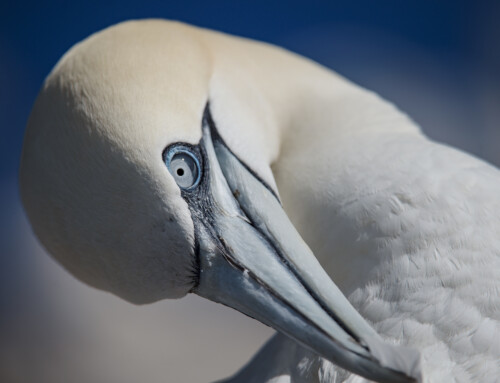LINKED PAPER
The mechanistic, genetic and evolutionary causes of bird eye colour variation. Corbett, E.C., Brumfield, R.T., Faircloth, B.C. 2023. IBIS. DOI: 10.1111/ibi.13276. VIEW
No one would consider cormorants to be the most colourful bird family – until you look at their eyes. Their striking irises range from turquoise (Double-crested), to sapphire blue (Brandt’s), forest green (European Shag), deep red (Long-tailed), and even a bicolored orange-and-teal sunset pattern (Bank). But even that impressive diversity is only a fraction of the array of eye colours that can be found in birds. While feathers receive most of the attention, bird eyes are equally dazzling in their variety: as illustrated by the collage below.

Figure 1. A sampling of the diversity of colours and patterns of bird irises. Species pictured are as follows. First row: a) Yellow-bellied Tanager Ixothraupis xanthogastra, b) Red-throated Loon Gavia stellata, c) Bank Cormorant Phalacrocorax neglectus, d) Green Heron Butorides virescens, e) Spot-billed Toucanet Selenidera maculirostris, f) Crested Oropendola Psarocolius decumanus, g) Northern Gannet Morus bassanus; Second Row: h) Three-streaked Tchagra Tchagra jamesi, i) Great Antshrike Taraba major, j) Painted Buttonquail Turnix varius, k) Short-eared Owl Asio flammeus, l) Green-billed Toucan Ramphastos dicolorus, m) American White Ibis Eudocimus albus, n) Wire-tailed Manakin Pipra filicauda; Third Row: o) Red-tailed Hawk Buteo jamaicensis, p) Philippine Frogmouth Batrachostomus septimus, q) Eurasian Eagle-Owl Bubo bubo, r) Sharp-shinned Hawk Accipiter striatus, s) Double-crested Cormorant Nannopterum auritum, t) Brown Cuckoo-Dove Macropygia phasianella, u) Acorn Woodpecker Melanerpes formicivorus; Fourth Row: v) Greater Roadrunner Geococcyx californianus, w) Crested Guan Penelope purpurascens, x) Black-capped Donacobius Donacobius atricapilla, y) Dalmatian Pelican Pelecanus crispus, z) Brandt’s Cormorant Urile penicillatus, aa) Satin Bowerbird Ptilonorhynchus violaceus, ab) King Vulture Sarcoramphus papa. Photographs used with permission, by Oscar Johnson (a), Bryan Calk (b), Peter Ryan (c), Gregory Ashmore (d), Caio Brito (e, l), Nathan Rupert (f), Colin Dixon (g), Ngulia Ringing Project (h), Diego Cueva (i), Ramit Singal (j), Mark Schultz (k), Shannon O’Shea (m), Marquette Mutchler (n, u, w, x), Mason Maron (o, r), Rich Lindie (p), westshorewalk22 on Flickr (q), Timothy Krieder (s), David C. Simon (t), Nathan Dubrow (v), Brian Dandridge (y), Sharif Uddin (z), Terence Alexander (aa), and Daniel Parent (ab).
When considering this incredible variation, the obvious question to ask is “why?” But there are many different answers, depending on how deeply or broadly we look. We could say that a bird has red eyes because it has red pigment in its irises. Or, because it has a particular variant of an “eye colour gene”. Or, because it uses its bright eyes as a display signal in the dark forest understory. Each of these explanations focuses on a different level of causation: from mechanistic, to genetic, to evolutionary. In our recent review, we surveyed over 100 years of research and found that, though some broad patterns have emerged, much work still remains to get a full understanding of the causes of bird eye colour (Corbett et al. 2023).
In bird feathers, the predominant pigments are melanins (black, brown, grey, rufous), and carotenoids (red, yellow, orange). Both are also present in bird eyes, but two other types of pigments – pteridines and purines – account for many brightly coloured bird eyes. A variety of other factors, including blood vessels, collagen fibres, cholesterol crystals, lipid droplets, and structural elements, can also contribute to eye colour. Complicating matters further, the same eye colours can be produced by a variety of different mechanisms, so we can’t make assumptions about the elements involved in a given species without conducting chemical analyses or examining the iris under a microscope. We do have information on iris pigments and structures for around 180 species, but 98% of species and 79% of families have been entirely unstudied so there is still much to uncover.

Figure 2. The same eye colours (white/grey, yellow, and red) can be produced by a range of pigments, structures, and their combinations. For each eye colour, examples of species are listed next to the iris colouration element(s) that give their eyes that colour.
We know even less about the genes involved in bird eye colour. Starting in the early 20th century, experimental crosses of domestic chickens and pigeons have identified some patterns of inheritance of eye colours, but the first specific eye colour gene in birds was identified only in the past few years. Three independent research groups studying domestic pigeons found that a mutation in a gene called SLC2A11B results in a lack of yellow pteridine pigment, creating what pigeon breeders call “pearl” eyes. So far, however, no similar genes have been identified in wild bird populations.

Figure 3. The pathways to produce orange and pearl irises in domestic pigeons. Data from Si et al. (2021), Andrade et al. (2021), and Maclary et al. (2021). Iris photographs © Jian-Ou Gao (Si. et al. 2021).
Studying pigments and genes can help us understand how bird eyes get their colour, but what advantages do colourful eyes provide in the first place?
One possibility is that they affect birds’ survival, through effects on their vision or camouflage. It’s not certain that the visible colour of the iris would affect how light reaches the retina, because there is a lot of light-absorbing pigment deeper in the eye that is not externally visible. Still, the idea that eye colour could influence visual acuity, perhaps by reducing glare, has yet to be tested. On the other hand, studies of owls and cavity-nesting birds have raised the possibility that eye colour could be associated with camouflage, with more vulnerable species like day-roosting owls and open-nesting songbirds having darker, less conspicuous eyes.
In many birds, signalling may play a greater role in the evolution of eye colour. The vivid eye colours of some birds-of-paradise, bowerbirds, and cormorants seem to be under the influence of sexual selection, just like colourful feathers. Since eye colour varies within species, it could serve as a marker of age, sex, or mate quality. Or, it could simply be an announcement of an individual’s presence: one experiment in jackdaws found that their bright eyes dissuaded rivals from approaching their nest cavities.
The study of bird eye colour variation has the potential for many new discoveries. Paying greater attention to eye colour variation, taking standardised eye photos during bird ringing and specimen collection, and harnessing the potential of photo databases like the Macaulay Library will give a more complete understanding of variation within and across species. Conducting High Performance Liquid Chromatography and other chemical analyses in a range of species will uncover the pigments and structures that underlie that variation. Whole-genome sequencing in polymorphic populations and hybrid zones will help identify the first eye colour genes in wild birds. And comparative phylogenetic analyses and behavioural experiments will identify and test hypotheses about the adaptive significance and evolutionary origin of bird eye colours. It will take many teams of researchers using disparate approaches, but the combined result of these efforts will be a much deeper understanding of the rainbow of colours found in bird eyes.
References
Andrade, P., Gazda, M.A., Araújo P.M., Afonso S., Rasmussen J.A, Marques C.I., Lopes R.J., Gilbert M.T.P, Carneiro M. 2021. Molecular parallelisms between pigmentation in the avian iris and the integument of ectothermic vertebrates. PLOS Genetics 17:e1009404. VIEW
Maclary, E. T., B. Phillips, R. Wauer, E. F. Boer, R. Bruders, T. Gilvarry, C. Holt, M. Yandell, and M. D. Shapiro. 2021. Two Genomic Loci Control Three Eye Colors in the Domestic Pigeon (Columba livia). Molecular Biology and Evolution 38:5376-5390. VIEW
Si, S., X. Xu, Y. Zhuang, X. Gao, H. Zhang, Z. Zou, and S.-J. Luo. 2021. The genetics and evolution of eye color in domestic pigeons (Columba livia). PLOS Genetics 17:e1009770. VIEW
If you want to write about your research in #theBOUblog, then please see here




